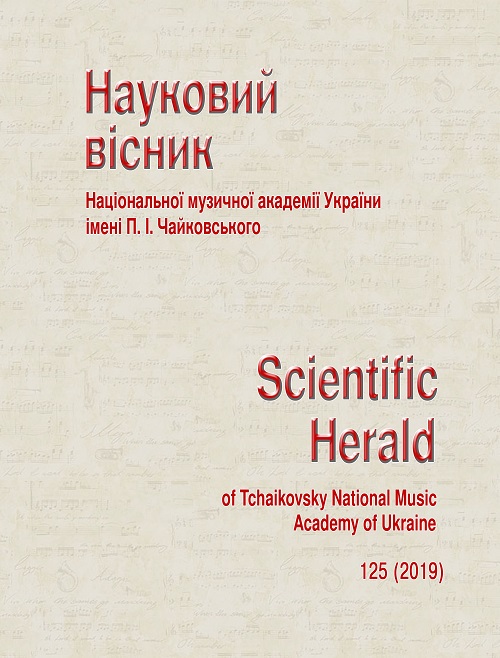The Architectonics of the First Concerto for the Piano and Orchestra by Serhii Prokofiev
DOI:
https://doi.org/10.31318/2522-4190.2019.126.197973Keywords:
architectonics, composition, composer style of S. Prokofiev, one-part concert, theme, tempo-rhythm, performance versionAbstract
Relevance of research. Architectonics in the works of S. Prokofiev is a scantily studied field of music science. The selected perspective is one of the ways of knowing the features of his composer style.
Research objective is to identify architectonics performance features in the First Piano Concerto with Orchestra by S. Prokofiev and two of his performance versions.
Research methodology. The basic concept of the article is V. Moskalenko’s musical architectonics definition. The study is based on a method of comparing the definitions of “musical composition” and “musical architectonics”. As a result, specific features of architectonics are defined, the interconnection between composition and architectonics in the composer style of S. Prokofiev is unfolded. Composer’s statements are interpreted as actualization of the role of architectonics in his composer way of thinking. A graphic model of the First Piano Concerto’s structure is suggested as a visualization technique for architectonical plan of the musical work.
Main results and study findings. Architectonics is a more general, panoramic plan of organizing the whole structure, as opposed to a composition, in which the process of composing is emphasized. The simultaneous perception of the parts’ ratio has a sign of aestheticism. The simultaneous representation by S. Prokofiev of the architectonic whole functions as a system-creating factor at all stages of the creative process. In the First Concert for Piano and Orchestra, this phenomenon is considered on three levels: 1) architectonics as a component of the composer's design, the existence of which in this case is confirmed by the words of the composer; 2) the implementation of architectonics in the text of musical work; 3) architectonic solutions of the sounding musical work in two performing versions. The mainstay of architectonics in the First Piano Concerto in Viennese classical compositional models provides constructive clarity, harmony, stability, strength and completeness. Musical content properties of the supporting structural elements and the specific rhythm of their location in the space of the musical composition are in harmony with this phenomenon. The conceptual difference of stylistic approaches of the architectonic reading in the considered performance versions confirms the inviolacy of the composer's constructive idea, which is a conventionally dimensional expression of his intonational concept.
The significance of the research results lies in the focus on performance, in the discovery of the practical possibilities of architectonics in musical interpretation. The research on architectonics functioning peculiarities in composer and performing arts helps to increase the artistic level and the scale of musical thinking of professional musicians and helps to demonstrate their creative manner.
Downloads
References
Asaf'ev, B. V. (1971). Musical form as а process. [Muzykal'naya forma kak protsess]. Leningrad: Muzyka, 376 p. [in Russian].
Aranovskii, M. G. (2009). Manuscript in the structure of the creative process: Essays on musical textology and the psychology of creativity. [Rukopis' v strukture tvorcheskogo protsessa: Ocherki muzykal'noy tekstologii i psihologii tvorchestva. M. I. Glinka, N. A. Rimsky-Korsakov, P. I. Tchaikovsky, S. V. Raсhmaninov, S. S. Prokofiev]. Moscow: Композитор, 340 p. [in Russian].
Moskalenko, V. G. (1994). The creative aspect of musical interpretation (to the problem of analysis). Research. [Tvorcheskiy aspekt muzykal'noy interpretatsii (k probleme analiza). Issledovanie]. Kyiv: Kyiv State Conservatory named after P. I. Tchaikovsky, 157 p. [in Russian].
Denisov, E. V. (1986). Sonata form in the works of S. Prokofiev. In: Denisov, E. V. Сontemporary music and problems of evolution of composer's technique. [Sonatnaya forma v tvorchestve S. Prokof'eva, Sovremennaya muzyka i problemy evolyutsii kompozitorskoy tehniki]. Moscow: Sovetskiy kompozitor, pp. 31–46 [in Russian].
Dolinskaya, E. B. (2005). Piano concert is in Russian music of the 20th century. Research essays [Fortepiannyiy kontsert v russkoy muzyke XX stoletiya. Issledovatel'skie ocherki]. Moscow: Kompozitor, 560 p. [in Russian].
Nazaykinskii, E. V. (1982). The Logic of musical composition. [Logika muzykal'noy kompozitsii]. Moscow: Muzyka, 319 p. [in Russian].
Prokof'ev, S. S. (1982). Autobiography. [Avtobiografiya]. 2nd ed. Moscow: Sovetskiy kompozitor, 600 p. [in Russian].
Prokof'ev, S. (2002). Diary. Vol. 1. 1907–1933 (part one). [Dnevnik. T. 1. 1907–1933 (chast' pervaya)], 812 p. Paris: sprkfv [in Russian].
Prokofiev about Prokofiev. Articles and interviews (ed.) V. Varunts. (1991). [Prokof'ev o Prokof'eve. Stat'i i intervyu]. Moscow: Sovetskiy kompozitor, 285 p. [in Russian].
Downloads
Published
How to Cite
Issue
Section
License
Our journal abides by the CREATIVE COMMONS copyright rights and permissions for open access journals.
Authors, who are published in this journal, agree to the following conditions:
The authors reserve the right to authorship of the work and pass the first publication right of this work to the journal under the terms of a Creative Commons Attribution License, which allows others to freely distribute the published research with the obligatory reference to the authors of the original work and the first publication of the work in this journal.
The authors have the right to conclude separate supplement agreements that relate to non-exclusive work distribution in the form in which it has been published by the journal (for example, to upload the work to the online storage of the journal or publish it as part of a monograph), provided that the reference to the first publication of the work in this journal is included.




